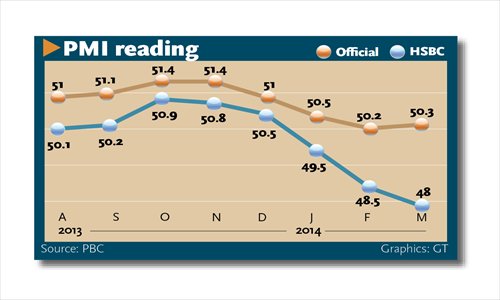March PMI gives hope of turnaround

Graphics: GT
China's manufacturing activity contracted for the fourth consecutive month in April, but at a slower pace, a preliminary survey showed on Monday. This added momentum to a possible turnaround in the world's second-largest economy since February.
The HSBC Flash Manufacturing Purchasing Managers' Index (PMI), the earliest reading of China's economic performance in April, rose to 48.3 in April from a final reading of 48 in March, data released by HSBC on Monday showed.
A PMI reading above 50 signals growth, while a reading below 50 indicates contraction.
A breakdown of the 11 sub-indexes shows five, including indexes for output and new orders, declined in April but at a slower pace. Meanwhile indexes for new export orders and employment fell further, the survey showed.
"Domestic demand showed mild improvement and deflationary pressures eased, but downside risks to growth are still evident, as both new export orders and employment contracted," Qu Hongbin, chief economist at HSBC, said in a statement.
The HSBC PMI is weighted more toward smaller private companies compared with the official PMI, which surveys a larger sample of bigger State-run firms.
"Today's reading is quite encouraging. Without a major stimulus in March and April, the country's economic data still improved. With mini-stimulus and a pickup of exports in the coming months, there is still room for the economy to grow," Yang Weixiao, a macroeconomic analyst with Lianxun Securities Co, told the Global Times Wednesday.
Last week, China released its major first-quarter economic data which showed the country's GDP grew 7.4 percent from a year earlier in the first quarter, down from the 7.7 percent growth in the previous quarter, which was the weakest growth since the third quarter of 2012.
Since early this year, all economic data and every policy rolled out has touched the nerves of global investors and economic observers. A slight pickup or fall in any data may be interpreted as a precursor of more good news or a hard landing, while any tiny policy may be read as the beginning of a major stimulus.
Zhang Bin, a research fellow at the Chinese Academy of Social Sciences, told the Global Times Wednesday that in the long term, the focus of China's economic activity has shifted from the manufacturing sector to the service and public infrastructure sectors, posing challenges to the existing policies and institutional arrangement. These will not match future development if they remain unchanged.
The Chinese leadership has said it will commit to reform and economic restructuring and will not use forceful short-term stimulus measures to boost the economy in the face of fluctuation.
"Reform is only one driving force to sustainable growth. Another force, which is equally important, is to improve government supervision and information disclosure to ensure public services are delivered as promised, and allow the government to get the right information about which areas it most needs to direct resources to," Zhang said.